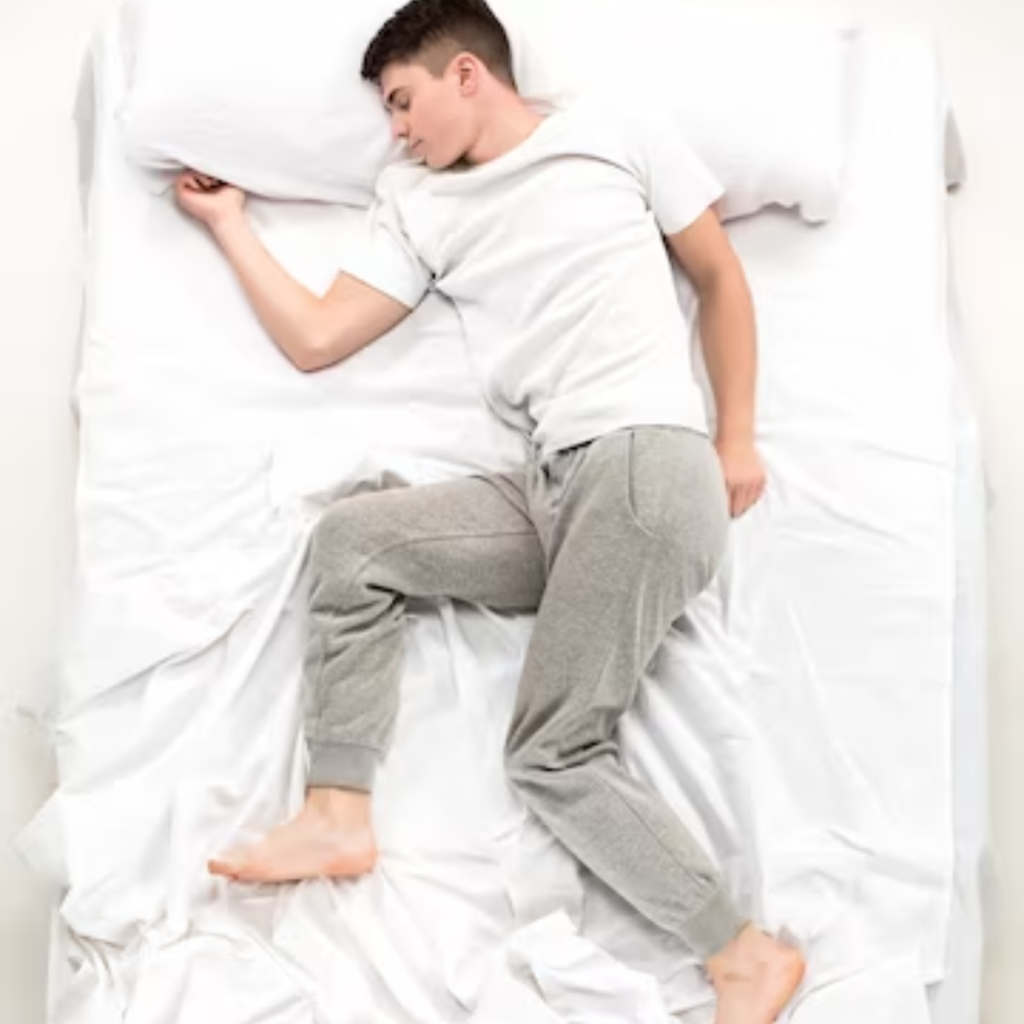Sleep Training: Sleep Aid Explained
09/13/2023

Welcome, dear reader, to the magical world of sleep, where dreams are spun and rest is won. In this enchanting realm, we're going to explore the concept of sleep training, a vital sleep aid that can turn those restless nights into peaceful slumbers. So, grab your favorite pillow, snuggle under your warmest blanket, and let's embark on this nocturnal journey together.
From understanding the basics of sleep training to exploring its various methods, from delving into its benefits to addressing common misconceptions, we'll leave no stone unturned. So, whether you're a sleep-deprived parent, a curious insomniac, or a sleep enthusiast, this glossary article is your ultimate guide to sleep training. Let's dive in, shall we?

The Basics of Sleep Training
Before we venture deeper into the land of dreams, let's first understand what sleep training is. In its simplest form, sleep training is a process that helps individuals, especially babies and toddlers, learn to fall asleep and stay asleep through the night. It's like teaching a child to ride a bike, but instead of wheels and pedals, we're dealing with pillows and dreams.
But why is sleep training necessary, you ask? Well, sleep is as essential to our health as food and water. It's the time when our body repairs itself, our brain sorts and stores memories, and we recharge for the day ahead. Without proper sleep, we can't function at our best. So, sleep training is not just about getting a good night's rest; it's about promoting overall health and well-being.
Understanding Sleep Cycles
Now, to understand sleep training, we first need to understand sleep cycles. A sleep cycle is a pattern of distinct stages of sleep that we cycle through multiple times each night. These stages include light sleep, deep sleep, and REM (Rapid Eye Movement) sleep. Each stage plays a crucial role in ensuring we wake up feeling refreshed and rejuvenated.
During light sleep, our body and brain start to slow down, preparing us for the deeper stages of sleep. Deep sleep is when our body repairs and regrows tissues, builds bone and muscle, and strengthens the immune system. REM sleep, on the other hand, is when we dream. It's also crucial for learning and memory. Understanding these cycles is key to effective sleep training, as it helps us identify the best times to sleep and wake up.
The Importance of Sleep Hygiene
Another essential concept in sleep training is sleep hygiene. No, it's not about brushing your teeth before bed (though that's important too!). Sleep hygiene refers to the habits and practices that can improve the quality of our sleep. This includes maintaining a regular sleep schedule, creating a sleep-friendly environment, and avoiding activities that can disrupt sleep, such as consuming caffeine or using electronic devices close to bedtime.
Good sleep hygiene is the foundation of effective sleep training. It sets the stage for a good night's sleep and makes it easier for us to fall asleep and stay asleep. So, if you're struggling with sleep, improving your sleep hygiene might be a good place to start.
Methods of Sleep Training
Now that we've covered the basics, let's explore the various methods of sleep training. Just like there are many ways to skin a cat (not that we're suggesting you should), there are many ways to train yourself or your little one to sleep. Each method has its pros and cons, and what works best will depend on your individual needs and circumstances.
From the gentle 'no tears' methods to the more controversial 'cry it out' methods, from the 'fading' methods to the 'chair' methods, we'll explore them all. So, buckle up, dear reader, as we dive into the fascinating world of sleep training methods.
The 'No Tears' Methods
First on our list are the 'no tears' methods. As the name suggests, these methods aim to teach babies to sleep without causing them distress. They involve gradually adjusting the baby's sleep habits, providing comfort and reassurance, and avoiding letting the baby cry. Some popular 'no tears' methods include the 'pick up, put down' method, the 'shush-pat' method, and the 'fading' method.
These methods are generally considered gentle and baby-friendly. However, they can be time-consuming and require a lot of patience. So, if you're a parent who's short on time or patience (and let's face it, who isn't?), these methods might not be for you. But if you're willing to put in the time and effort, these methods can be very effective.
The 'Cry It Out' Methods
Next up are the 'cry it out' methods. These methods involve letting the baby cry for short, controlled periods to teach them to self-soothe and fall asleep on their own. The most famous 'cry it out' method is probably the 'Ferber method', named after its creator, Dr. Richard Ferber.
While these methods can be effective, they're also controversial. Critics argue that they can cause unnecessary distress to the baby and damage the parent-baby bond. However, proponents argue that they're a quick and effective way to teach babies to sleep. So, if you're considering these methods, it's important to do your research and make an informed decision.
Benefits of Sleep Training
Now that we've explored the various methods of sleep training, let's look at why it's worth the effort. From improved sleep quality to better mood and performance, the benefits of sleep training are numerous and far-reaching.
But don't just take our word for it. Let's delve into the science behind these benefits and see how sleep training can transform your nights and days.
Improved Sleep Quality
The most obvious benefit of sleep training is improved sleep quality. By teaching ourselves or our little ones to fall asleep and stay asleep, we can ensure that we get the restful, uninterrupted sleep that our bodies and brains need. This can lead to better physical health, improved cognitive function, and a greater sense of well-being.
Research has shown that sleep training can increase the amount of time we spend in the deeper, more restorative stages of sleep. This can boost our immune system, aid in tissue repair and growth, and improve our memory and learning. So, if you're looking for a way to boost your health and performance, sleep training might be the answer.
Reduced Sleep Problems
Sleep training can also help reduce sleep problems, such as insomnia, sleep apnea, and restless leg syndrome. By promoting good sleep hygiene and healthy sleep habits, sleep training can address the underlying causes of these problems and improve sleep quality.
For example, sleep training can help manage insomnia by teaching individuals to associate their bed with sleep, rather than with activities that can disrupt sleep, such as watching TV or using a smartphone. Similarly, sleep training can help manage sleep apnea by promoting weight loss and encouraging side sleeping. So, if you're struggling with sleep problems, sleep training might be worth a try.
Common Misconceptions About Sleep Training
Despite its benefits, sleep training is often misunderstood. From the belief that it's cruel and unnecessary to the idea that it's a quick fix for all sleep problems, there are many misconceptions about sleep training.
But fear not, dear reader. We're here to dispel these myths and shed light on the truth about sleep training. So, let's dive into some of the most common misconceptions about sleep training and see what the science has to say.
Misconception 1: Sleep Training is Cruel
One of the most common misconceptions about sleep training is that it's cruel. Critics argue that letting a baby cry or forcing them to sleep when they're not tired can cause unnecessary distress and harm. However, research has shown that when done correctly, sleep training can actually be beneficial for both babies and parents.
Studies have found that sleep training can improve babies' sleep quality, reduce their night wakings, and improve their mood and behavior. It can also reduce parental stress and improve parental sleep. So, while it's important to be sensitive to a baby's needs and emotions, sleep training is not inherently cruel or harmful.
Misconception 2: Sleep Training is a Quick Fix
Another common misconception about sleep training is that it's a quick fix for all sleep problems. However, sleep training is not a magic bullet. It's a process that requires time, patience, and consistency. It's also not a one-size-fits-all solution. What works for one person or baby might not work for another.
Furthermore, sleep training is not just about teaching individuals to fall asleep and stay asleep. It's also about promoting healthy sleep habits and good sleep hygiene. So, while sleep training can help improve sleep quality and reduce sleep problems, it's not a cure-all solution.

Conclusion
And there you have it, dear reader. From the basics of sleep training to its various methods, from its benefits to common misconceptions, we've explored the magical world of sleep training in all its glory. We hope this glossary article has enlightened you and inspired you to embark on your own sleep training journey.
Remember, sleep is not a luxury; it's a necessity. So, whether you're a sleep-deprived parent, a restless insomniac, or a sleep enthusiast, sleep training can help you achieve the restful, rejuvenating sleep that you deserve. Sweet dreams!

 Back to Blog
Back to Blog